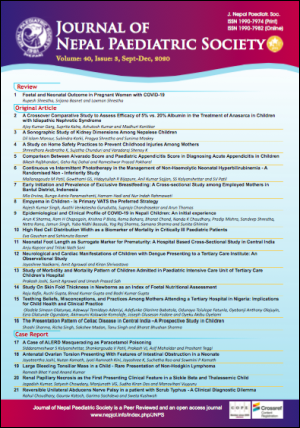Neonatal Foot Length as Surrogate Marker for Prematurity: A Hospital Based Cross-Sectional Study in Central India
DOI:
https://doi.org/10.3126/jnps.v40i3.29228Keywords:
Gestational age, High risk newborn, PretermAbstract
Introduction: Neonatal mortality is higher in premature babies, more so when identification and intervention is delayed. This study was aimed to find out the effectiveness of foot length measurement, a simple and inexpensive method, for identifying premature babies at birth.
Methods: This cross sectional study was conducted on 514 hospital born neonates. Their foot length, birth weight, length and head circumference were measured and compared with gestational age assessed by new Ballard score.
Results: Amongst 514 newborns, 71.6% were term and 28.4% were preterm. Mean foot length in term and pre-term babies were 7.30 cm (SD + 0.39) and 6.81 cm (SD + 0.52) respectively (p value < 0.0001). Pearson's correlation coefficient between gestational age as assessed by new Ballard score and foot length, birth weight, length and head circumference all showed significant positive correlation in the decreasing order [maximum with foot length (r = 0.802)]. Linear regression analysis for gestational age with foot length also had highest coefficient of determination R2 = 0.760 (P < 0.001). Foot length with cut-off < 6.83 cm has higher AUC (Area Under Curve) and is a good marker for predicting prematurity with a sensitivity of 94.57%, and a specificity of 41.99%.
Conclusions: Foot length measurement can be a good surrogate marker to predict prematurity as significant correlation is seen between it and gestational age assessed by new Ballard score.
Downloads
Downloads
Published
How to Cite
Issue
Section
License
Authors who publish with this journal agree to the following terms:
Authors retain copyright and grant the journal right of first publication with the work simultaneously licensed under a Creative Commons Attribution License that allows others to share the work with an acknowledgement of the work's authorship and initial publication in this journal.
Authors are able to enter into separate, additional contractual arrangements for the non-exclusive distribution of the journal's published version of the work (e.g., post it to an institutional repository or publish it in a book), with an acknowledgement of its initial publication in this journal.
Authors are permitted and encouraged to post their work online (e.g., in institutional repositories or on their website) prior to and during the submission process, as it can lead to productive exchanges, as well as earlier and greater citation of published work (See The Effect of Open Access).



